
The Anatidae are the biological family of water birds that includes ducks, geese, and swans. The family has a cosmopolitan distribution, occurring on all the world's continents except Antarctica. These birds are adapted for swimming, floating on the water surface, and in some cases diving in at least shallow water. The family contains around 174 species in 43 genera.
Ptychalaea is a fossil genus of very small, air-breathing land snails, terrestrial pulmonate gastropod molluscs in the family Gastrocoptidae.
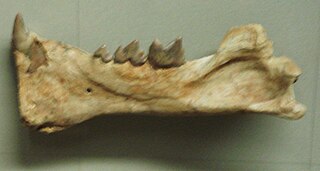
Prosansanosmilus is an extinct genus of barbourofelid that lived in Europe during the Late Miocene epoch, existing for approximately 0.9 million years. It contains Prosansanosmilus peregrinus, which died out in the Miocene epoch.

Strophocheilidae is a taxonomic family of air-breathing land snails, terrestrial pulmonate gastropod mollusks in the superfamily Acavoidea.
†Filholiidae is an extinct family of fossil air-breathing land snails, terrestrial pulmonate gastropod mollusks in the superfamily Clausilioidea.

Klikia is a genus of fossil air-breathing land snails, a terrestrial pulmonate gastropod molluscs in the family Elonidae.
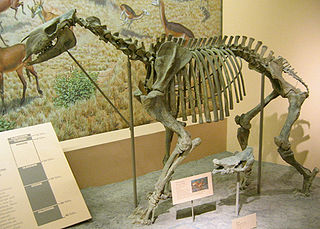
Schizotheriines are one of the two subfamilies of the extinct family Chalicotheriidae, a group of herbivorous odd-toed ungulate (perissodactyl) mammals that lived from the Eocene to the Pleistocene. The other clade is the Chalicotheriinae. Both clades had claws rather than hooves on their front feet, an adaptation understood as related to feeding. Schizotheriines also had claws on their hind feet. The fossils of both groups are found in environments that had trees and shrubs. While chalicotheriines developed very derived body forms, schizotheriines remained basically similar in shape to other perissodactyls such as horses and tapirs. Like most forest-dwelling ungulates, they had long necks and forelimbs longer than their hindlimbs. Schizotheriines had longer, higher-crowned cheek teeth than chalicotheriines, which indicates they typically fed on tougher vegetation. The sediments where their fossils are found show they also lived in a wider range of environments, from moist forests to drier woodland or savannah-like environments with trees. Perhaps for this reason, they became more widely distributed than chalicotheriines. Though chalicotheres likely evolved in Asia, schizotheriine fossils are also found in Africa and North America, which they reached by the Bering land bridge. The best-known schizotheriine genus is Moropus. The last survivor of the group was traditionally thought to be Nestoritherium, but it was found to actually be a member of Chalicotheriinae.
In biostratigraphy, MN 5 is one of the MN zones used to characterize the fossil mammal faunas of the Neogene of Europe. It is preceded by MN 4 and followed by MN 6 and is part of the Orleanian age of the middle Miocene. MN 5 starts within magnetostratigraphic chron C5Cr, at 17.0 million years ago, and ends at the start of chron C5Bn.1r, at 15.0 million years ago, although some different correlations have been proposed. The reference locality used to correlate faunas with this zone is Pontlevoy-Thenay in France; other localities include La Retama in Spain, Castelnau-d'Arbieu in France, and Sandelzhausen in Germany.
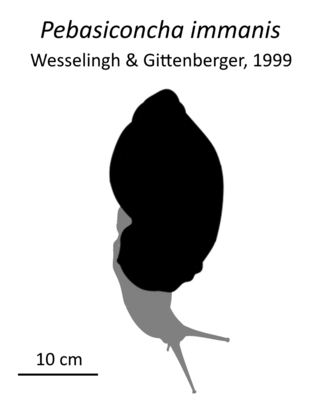
Pebasiconcha immanis is an extinct species of air-breathing land snail, a terrestrial pulmonate gastropod mollusk in the family Acavidae. The type locality of Pebasiconcha immanis is the Miocene Pebas Formation in the Colombian and Peruvian Amazonia.

Urticicola is a genus of air-breathing land snails, terrestrial pulmonate gastropod mollusks in the subfamily Trochulininae of the family Hygromiidae, the hairy snails and their allies.

Ampullinopsis is an extinct taxonomic genus of deep-water sea snails, marine gastropod molluscs in the clade Sorbeoconcha. These sea snails were epifaunal grazers. Sea snails of this genus lived from Paleocene epoch to Miocene epoch.

Eoborus is a fossil genus of medium-sized air-breathing land snails, terrestrial pulmonate gastropods in the family Strophocheilidae. Eoborus is the oldest fossil record of Strophocheilidae, dating from the Middle Paleocene of Brazil and Uruguay. The Brazilian species, alongside Eoborus charruanus from Uruguay, are the oldest fossil record of the family.
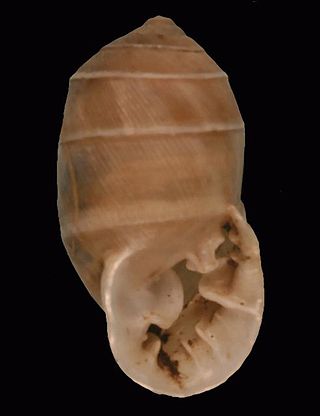
Plagiodontes is a recent genus of small to medium-sized air-breathing land snails, terrestrial pulmonate gastropods in the family Odontostomidae.
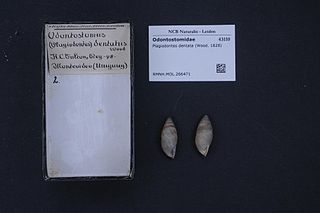
Plagiodontes dentatus is a recent species of small to medium-sized air-breathing land snail, terrestrial pulmonate gastropods in the family Orthalicidae, subfamily Odontostominae. It occurs in Entre Ríos Province, Argentina.
This list, 2013 in molluscan paleontology, is a list of new taxa of ammonites and other fossil cephalopods, as well as fossil gastropods, bivalves and other molluscs that have been described during the year 2013.
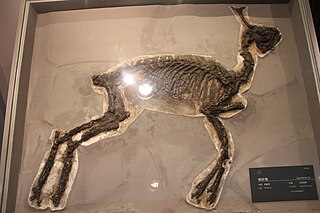
Lagomeryx is a genus of prehistoric ungulate that lived in Eurasia from the lower to middle Miocene. Fossil remains were found in Europe and Asia.

Gastrocoptidae is a family of minute, air-breathing land snails, terrestrial pulmonate gastropod molluscs in the superfamily Pupilloidea.

Titanochelon is an extinct genus of giant tortoises known from the Early Miocene to the beginning of the Pleistocene in Europe, extending from the Iberian Peninsula to Anatolia. Some members of the genus were larger than extant giant tortoises, with a shell length of up to 2 m.
Zonitoides suevicus is an extinct species of small, air-breathing land snail, a terrestrial pulmonate gastropod mollusk in the family Gastrodontidae.













